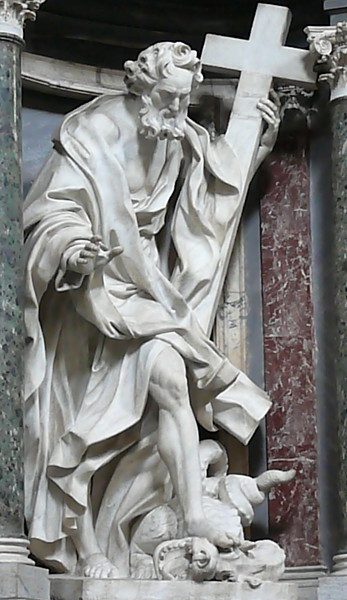St. Philip and the Dragon
St. Philip, when he had preached in Scythia by the space of twenty years, he was taken of by the paynims, pagans which would wanted to constrain him to make sacrifice to an idol which was called Mars, their God. And anon immediately under the idol issued out a right great dragon, which forthwith slew the bishop's son that appointed prepared the fire for to make the sacrifice, and the two provosts also, whose servants held St. Philip in iron bonds. And the dragon corrupted the people with his breath that they all were sick, and St. Philip said: Believe ye me and break this idol and set in his place the cross of Jesu Christ and after, worship ye it, and they that be here dead shall revive, and all the sick people shall be made whole.And they that were sick cried to St. Philip, and said: If thou mayst do so much that we may be guerished cured and whole, we shall gladly do it.
And anon St. Philip commanded the dragon that he should go in to desert without grieving or doing any harm to any person, and anon he departed without appearing after; and forthwith St. Philip healed all them that were sick, and raised the three that were dead, and were all baptized, and preached to them the space of a year the faith of Jesu Christ.
He Confutes the Hebronites
And when he had ordained priests and deacons, after he departed and came into the city of Hierapolin in Asia, where he destroyed the heresy of the Hebronites, which said and preached that Jesu Christ had not taken very true flesh human, but only the semblance of the body human. In this city were his two daughters, by whom our Lord had converted much people to the Christian faith.His Martyrdom
St. Philip tofore his death made to come tofore him all the bishops, seven days tofore his death, and also all the priests, and said to them: These seven days hath our Lord given to me respite for to warn advise you to do well. And he was of the age of eighty-seven years. And after this the paynims took and held him, and fastened him to the cross, like unto his master, and so he yielded up his soul and died. And his body was worshipfully honorably buried there, and his two daughters died long after him and were also buried, that one on the right side, and that other on the left side of the body of their father.Isidore of Seville on St. Philip
Isidore writeth in the book of the life and death of saints, and saith that Philip preached to the Frenchmen, and to men that were in darkness, he enlightened them in the faith. After, he was taken in the city of Hierapolin of the paynims, and of them stoned and crucified, of whom the martyrology of holy church speaketh not.St. Philip of Cæsarea
But of another Philip, which was one of the seven deacons, St. Jerome saith in the martyrology that he was buried in the city of Cæsarea, where God showed many fair miracles for him, beside whom three of his daughters be buried, and the fourth daughter lieth at Ephesus. The first Philip differenceth from this Philip, for he the former was an apostle and this the latter was a deacon. The apostle resteth at Hierapolin, and the deacon at Cæsarea; he had two daughters, and this four. Though Historia Ecclesiastica saith that Philip the apostle had four daughters prophetesses, but it is herein more to believe St. Jerome.Then let us pray to the holy St. Philip that he pray for us to our Lord that we may come to his bliss. Amen.
This text was taken from the Internet Medieval Source Book. E-text © by Paul Halsall. Annotations, formatting, and added rubrics by Richard Stracke. The drop initial (first letter of the text) is from the Isabella Capitals font by John Stracke. Permission is granted for electronic copying, distribution in print form for educational purposes and personal use. If you do reduplicate the document, indicate the sources. No permission is granted for commercial use.
Golden Legend Table of Contents
Christian Iconography Home Page

St. Philip's attribute is a tall cross. (See the description page for this image and the page explaining the iconography of images of this saint.)
VORAGINE'S ETYMOLOGY FOR THE NAME PHILIP
Philip is as much to say as the mouth of a lamp, or the mouth of hands. Or it is said of philos, that is as much to say as love, and of yper, that is to say sovereign, so Philip is as much to say as love of sovereign things. Then is it said, mouth of a lamp for his clear preaching, and mouth of the hands for his busy work, and love of things sovereign for his celestial love and contemplation.